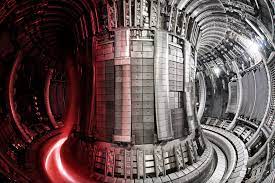Sam Shead reports in CNBC:
DeepMind, which is owned by Alphabet, announced that it has trained an AI system to control and sculpt a superheated plasma inside a nuclear fusion reactor. Applications of reinforcement learning “could dramatically accelerate the development of fusion reactors and, ultimately, our ability to fight global change.” The process, which releases vast amounts of energy, has been touted as a potentially limitless source of clean energy, but a number of technical challenges still need to be overcome.Scientists at DeepMind have found another real-world application for their artificial intelligence software.
The London-based AI lab, which is owned by Alphabet, announced Wednesday that it has trained an AI system to control and sculpt a superheated plasma inside a nuclear fusion reactor.
Nuclear fusion, a process that powers the stars of the universe, involves smashing and fusing hydrogen, which is a common element of seawater.
The process, which releases vast amounts of energy, has been touted as a potentially limitless source of clean energy, but a number of technical challenges still need to be overcome.
Here on Earth, scientists use tokamaks — doughnut-shaped vessels surrounded by electromagnetic coils — to try to recreate the nuclear fusion reactions that occur in outer space.
The magnets in these tokamaks are used to “contain” the volatile hydrogen plasma, which is hotter than the core of the sun. Controlling the magnetic coils currently requires multiple layers of complex control systems.
Martin Riedmiller, control team lead at DeepMind, and co-author of a paper published in the journal Nature on Wednesday, told CNBC that it’s “a really complex” control problem.
Together with the Swiss Plasma Center at EPFL, a university in Lausanne, Switzerland, DeepMind said it has developed a reinforcement learning AI system that can control the magnets and change their voltage thousands of times per second.
Reinforcement learning, an AI training technique that DeepMind is particularly bullish on, involves programming an AI to take certain actions in order to maximize its chance of earning a reward in a particular situation. In other words, the algorithm “learns” to complete a task by seeking out these preprogrammed rewards.
DeepMind’s unnamed AI, developed on a virtual simulator, has been used around 100 times on a tokamak at the Swiss Plasma Center known as the Variable Configuration Tokamak. It controlled the magnets in the tokamak for two seconds, which is the maximum amount of time the reactor can run before it overheats.
Roughly 10-20 people from DeepMind worked on the AI system together with around 5-10 people from EPFL.
“Fusion as I see it is one of the most fundamental energy sources that we have in the entire universe,” Federico Felici, a research Scientist at the Swiss Plasma Center, told CNBC. “Once we actually master this technology...it’s a huge achievement because you will be able to have near be limitless energy for the foreseeable.”
Damien Ernst, a professor at Universite de Liege who was not involved in the work, hailed the research as one of the most important applications of reinforcement learning so far, adding that it “could dramatically accelerate the development of fusion reactors and, ultimately, our ability to fight global change.”
DeepMind set out to crack artificial general intelligence, which is often referred to as the holy grail of AI.
The company started by developing AI systems that could master games like chess and Go. Now, it wants to apply more of its technology to real world applications and science.
While Google has found uses for DeepMind’s AI, its technology has not been widely applied elsewhere.
DeepMind CEO Demis Hassabis said in a statement that the company has demonstrated AI’s potential to accelerate scientific progress and open new avenues of research across biology, chemistry, mathematics and now physics.
DeepMind employs about 1,000 people worldwide, including some of the world’s leading AI research scientists, who can command annual salaries of more than $1 million. These top people, who often have Ph.D.s from the likes of Oxford, Cambridge, Stanford and MIT, can command this sort of money because they’re also sought after by Big Tech companies like Facebook, Apple, Amazon and Microsoft.




















0 comments:
Post a Comment